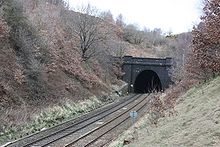- Morley Tunnel
-
Morley Tunnel is a railway tunnel in West Yorkshire, England, that is situated between Morley railway station and Batley railway station on the Huddersfield Line. From its northern end (53°44′56″N 1°35′34″W / 53.7490°N 1.5927°W), it extends 4,320 yards (3,950 m), passing beneath Morley town centre, to its southern end (53°43′34″N 1°37′09″W / 53.7260°N 1.6192°W).
Contents
History
Work started on the tunnel in 1845, with the first stone being laid at the Batley end of the tunnel on Monday, 23 February 1846. On that day at 12 o'clock a procession arrived at the Batley end, consisting of the 69th Infantry Band followed by workmen involved with the project (each holding aloft a banner), the directors, the contractors and other interested parties. The first stone was laid by John Gott, Esq., chairman of the Leeds, Dewsbury and Manchester Railway, and he marked this occasion by addressing the crowd and handing over £50 to the workmen in the hope it would contribute to their enjoyment and the festivities of the day. The mallet and the trowel used to lay the first stone were engraved with the coat of arms of Mr. Gott, with the following inscription:
Presented by the contractors of the Morley tunnel to John Gott, Esq., chairman of the Leeds, Dewsbury, and Manchester Railway, on the occasion of laying the first stone of that work. Feb. 23rd, 1846.[1]
A brass plate was attached to the stone, with the inscription:
This, the first stone of the Morley tunnel of the Leeds, Dewsbury, and Manchester Railway, was laid by the chairman, John Gott, Esq., of Armley, near Leeds, on Monday, 23rd February, 1846. Directors, Christopher Beckett, Thomas Benyon, Joseph Brook, William Brown, Thomas Cooke, James Garth Marshall, David William Nell, and Thomas Starkey. Thomas Granger, engineer. Jones and Pickering, contractors.[1]
The tunnel was finally completed in 1848, when the last keystone was placed at the Morley end of the tunnel by Mr. Granger, the principal engineer. The completion of the tunnel created much excitement around the town, and a band marked this occasion when it played at the event. The completion of the tunnel provided a much needed rail link between Yorkshire and Lancashire. During construction, 23 working shafts were sunk in addition to the four permanent vent/construction shafts still in use today at Town End, Hopewell Farm, America Moor and Howley Park. At one time men worked at 48 different points along the length of the tunnel. This was made possible by using steam engines to lower men down the working shafts to the level of the tunnel and raising stone and clay to the surface.
Eleven powerful steam engines, 15 double horse gins, 2000 men and 350 horses were used during the construction of the tunnel, and the work caused a huge change to the then known landscape, particularly in the area where Morley Low station is situated, where a huge cutting had to be excavated and the valley stream had to be culverted. At its deepest point the tunnel is 400 feet below ground level. It is almost level throughout its length except for a slight gradient to allow for drainage. The tunnel is 26 feet (7.9 m) high and 26 feet wide to accommodate two tracks.
Along the course of the tunnel tons of sandstone and clay were excavated and raised to the surface via construction shafts and dumped on spoil heaps, two of which were by the Townend shaft on South Queen Street and Melbourne Street. St Pauls Church, which stands on South Queen Street, was known as "the church on the spoil heap", as the hill it stands on is not a natural hill but the spoil heap of Morley Railway Tunnel. Much of the sandstone which was brought to the surface was used as building material, and King Brickworks, which was located near to where The Fountain public house is today, produced bricks from the excavated sandstone. Much of the sandstone not suitable for this was used in road building.
Today
Today the tunnel is used by the local services run by Northern Rail and the long distance services between Leeds and Manchester Piccadilly by First TransPennine Express.
References
- ^ a b Wakefield: Its History and Other Local Information, reproducing Thomas Baines, Yorkshire, Past and Present (London: W. Mackenzie, 1871–77), vol. II, chap. 6.
External links
Categories:- Railway tunnels in England
- Transport in West Yorkshire
- Tunnels completed in 1848
Wikimedia Foundation. 2010.


